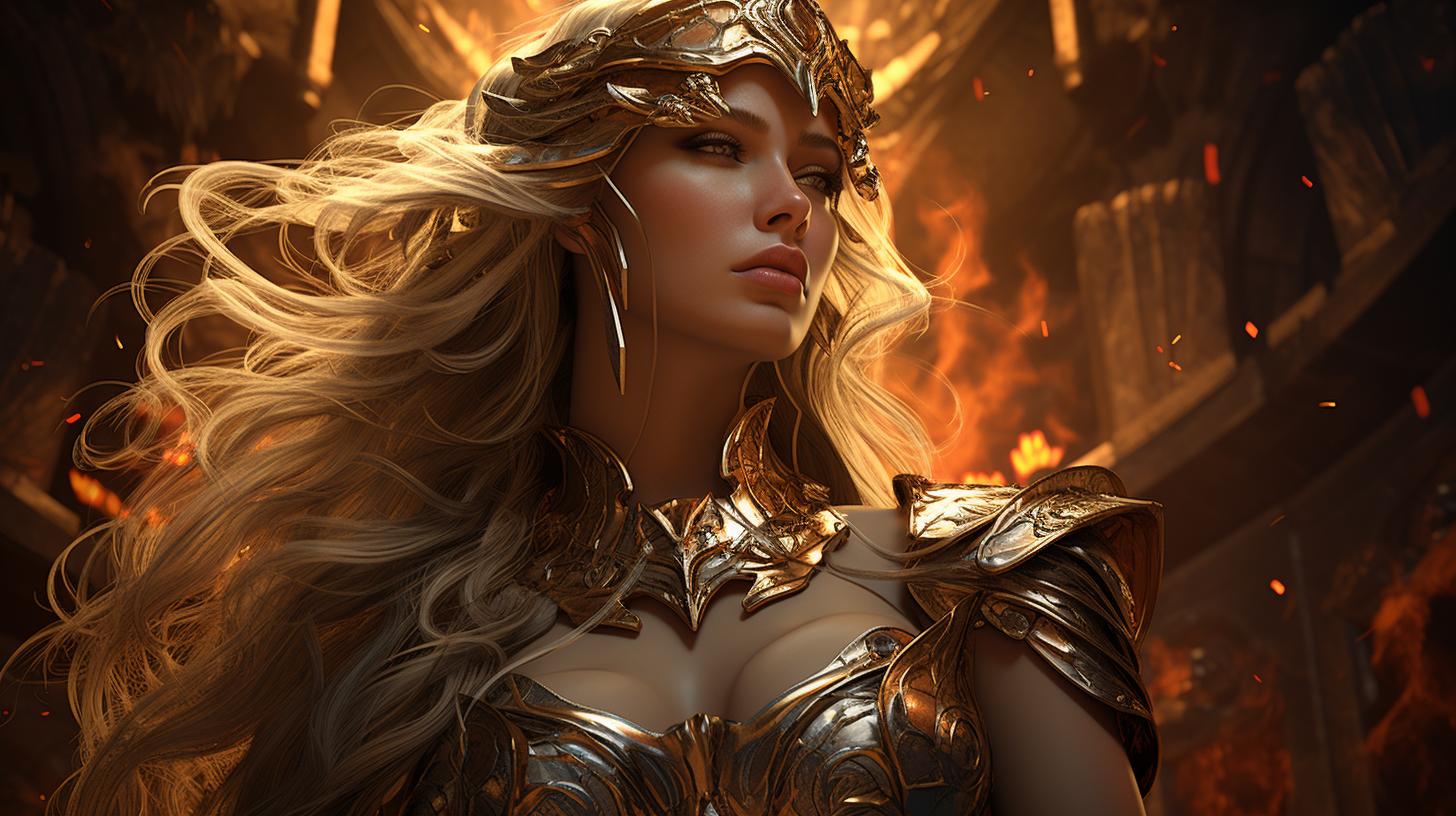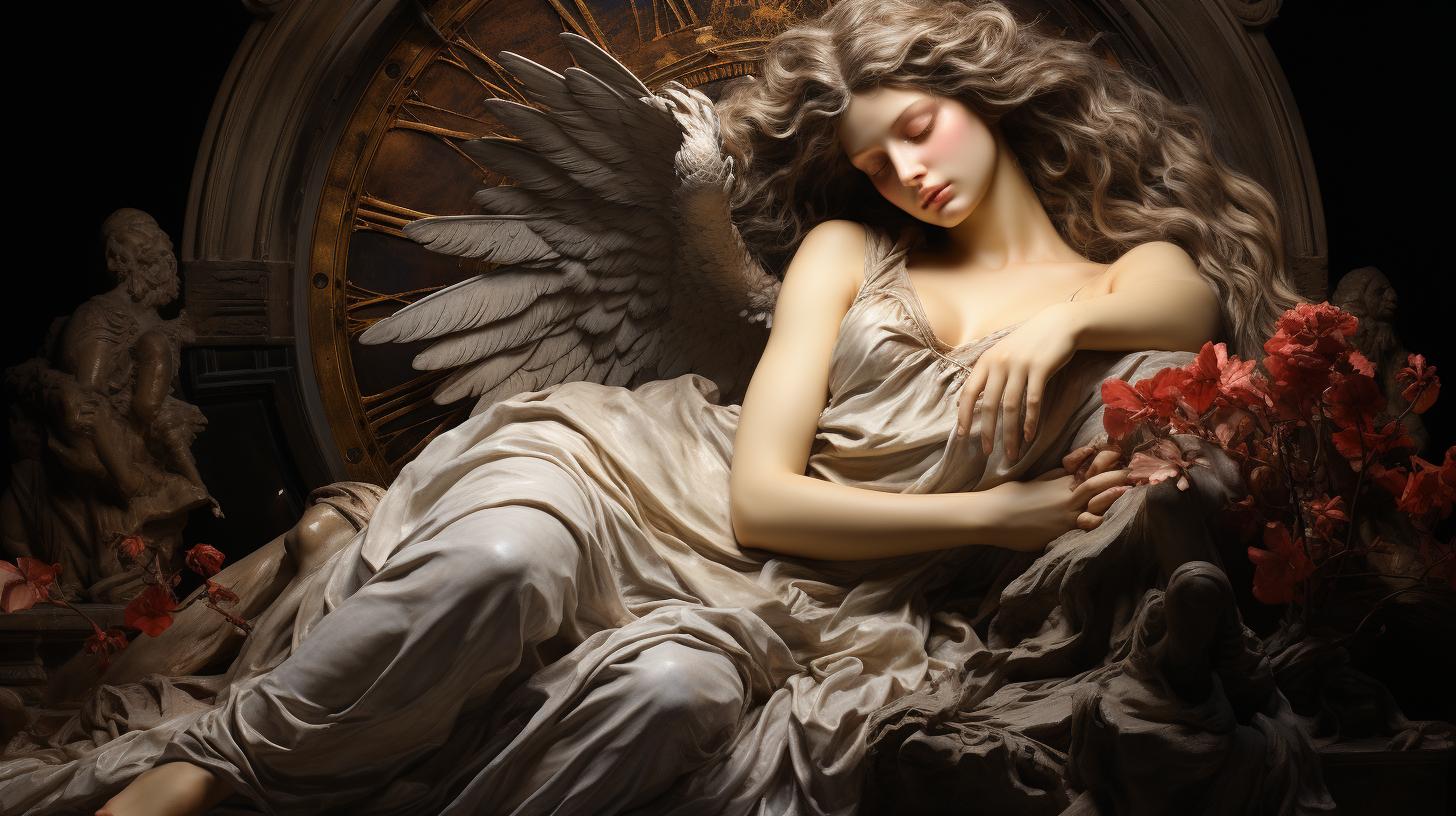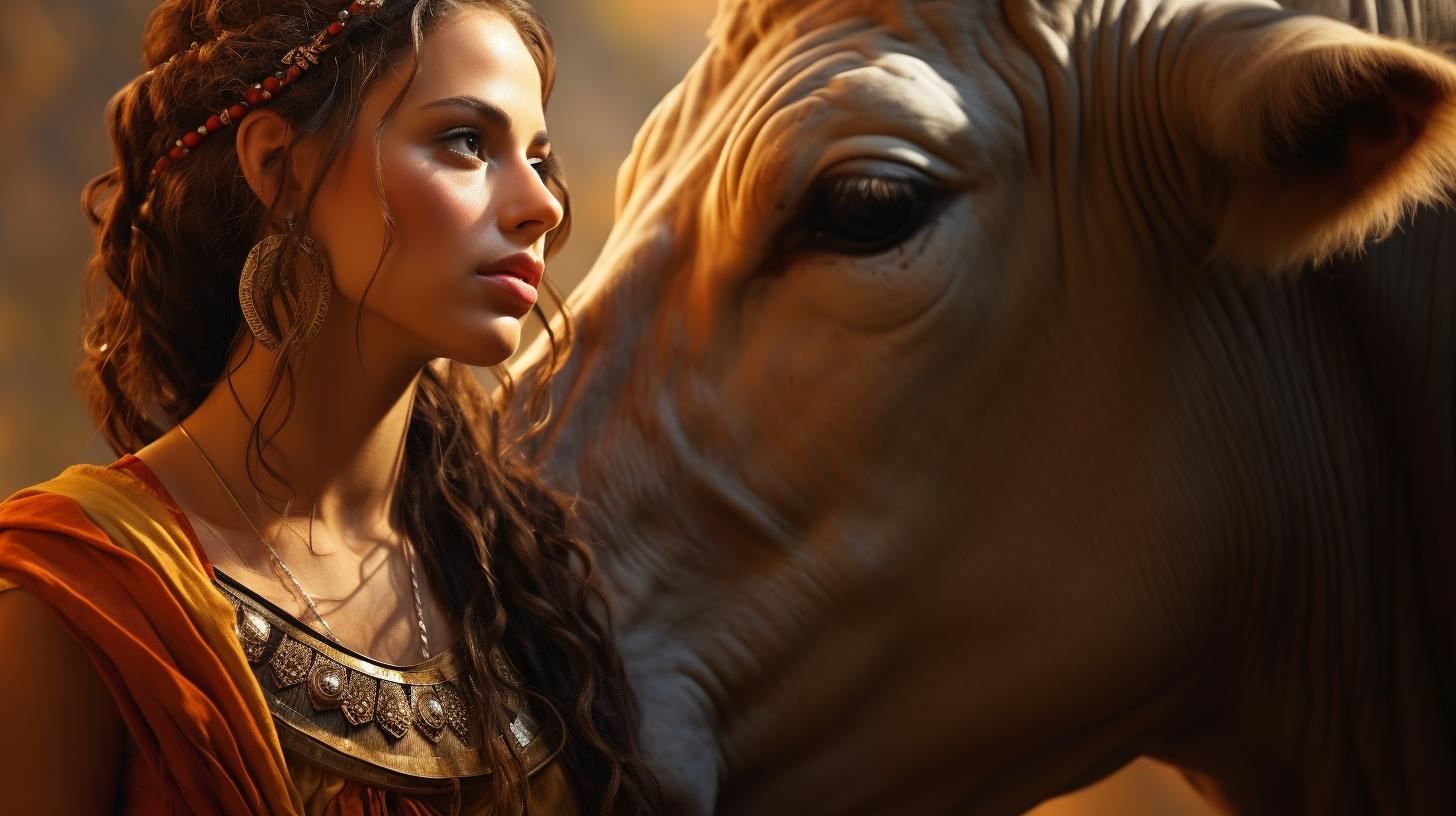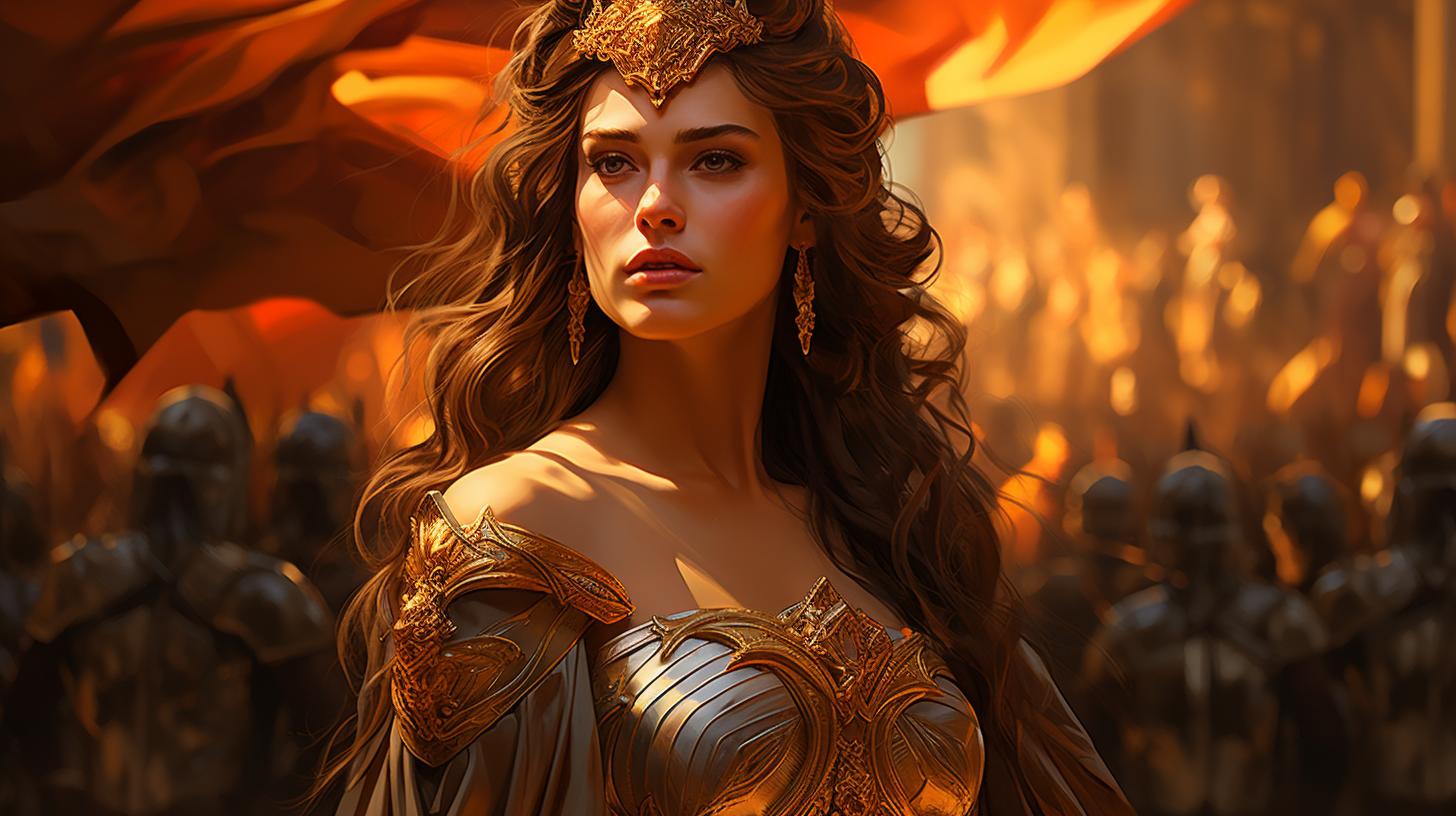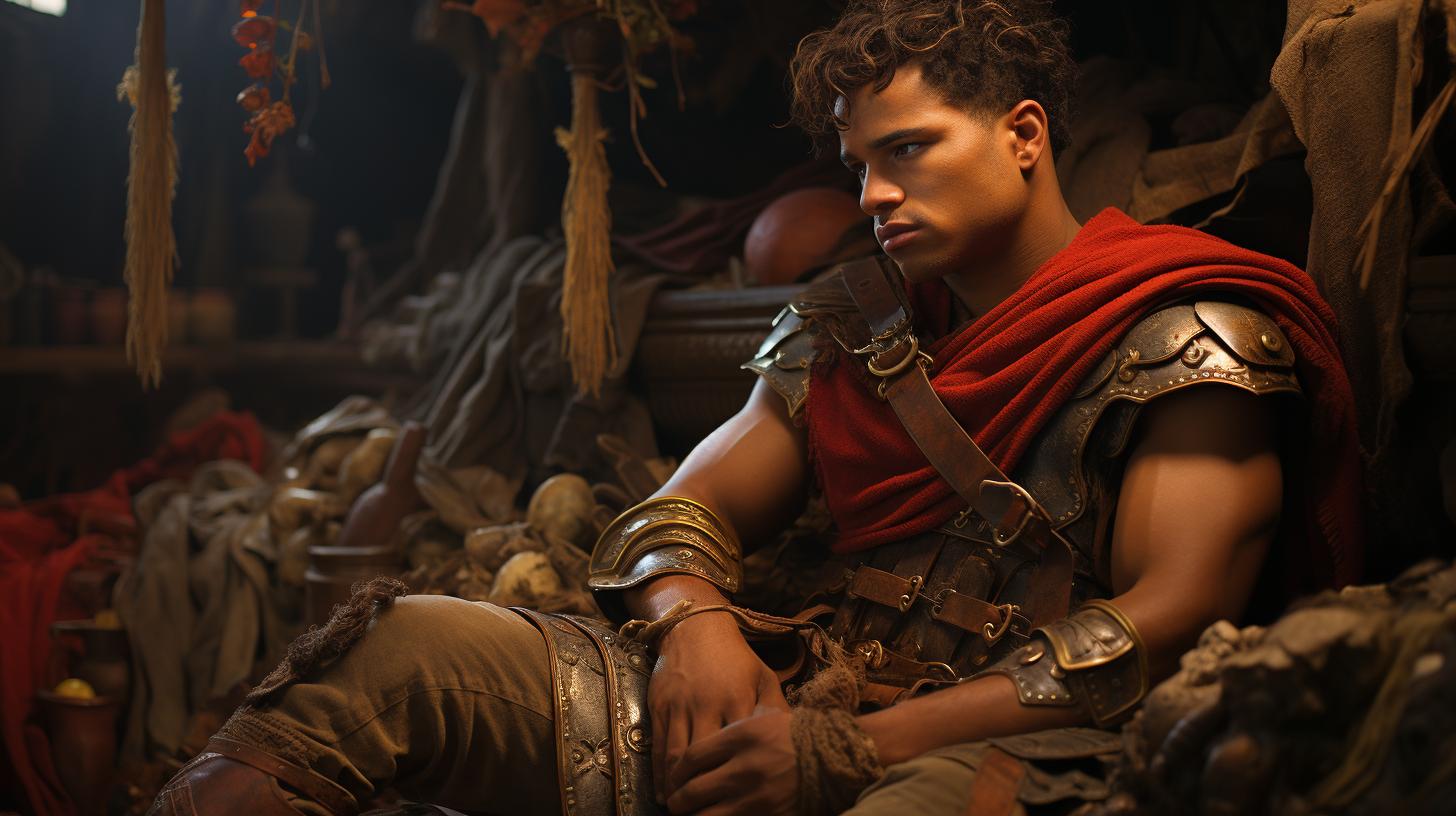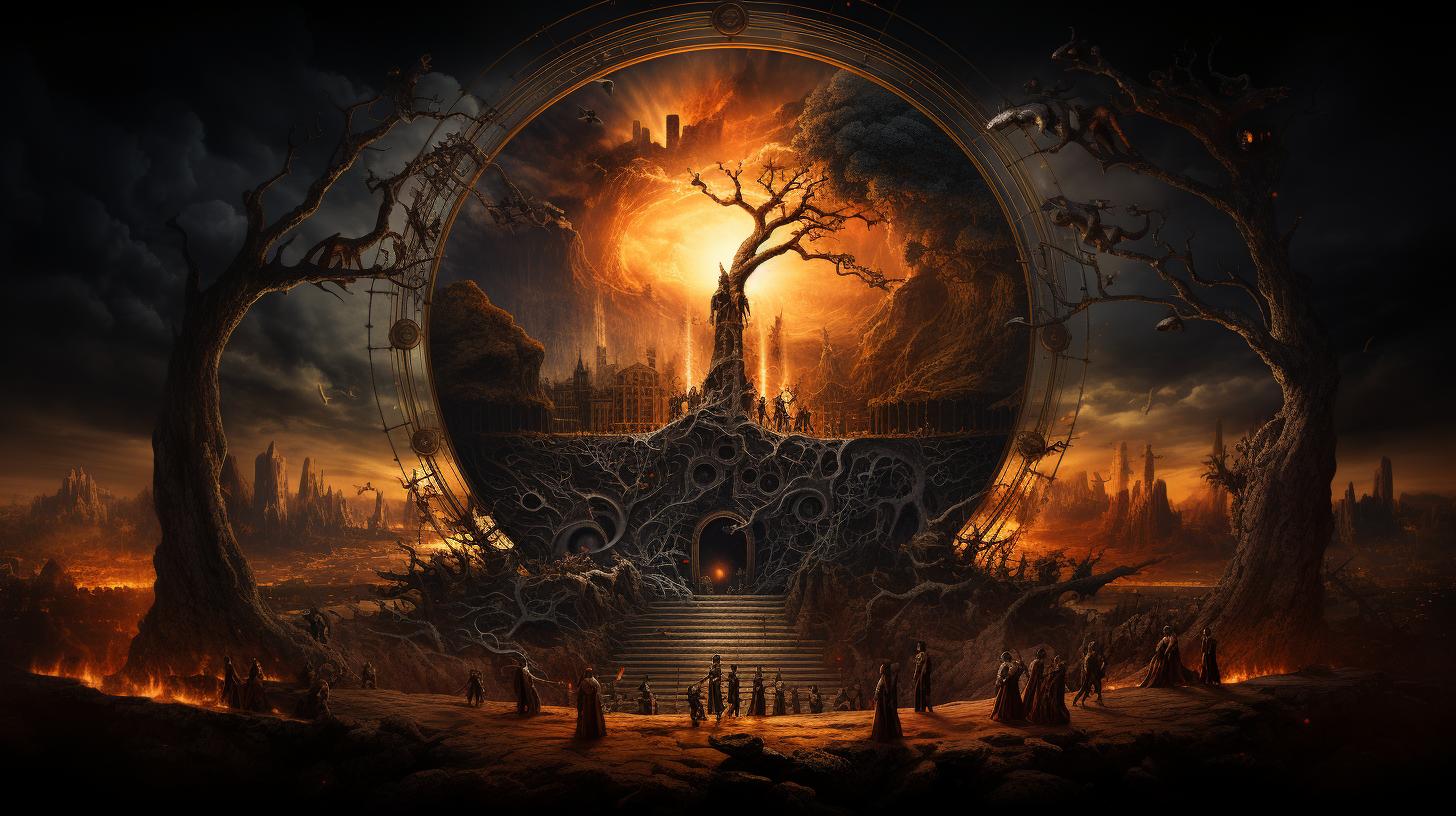Pallas Greek Mythology: Stories and Significance Explained
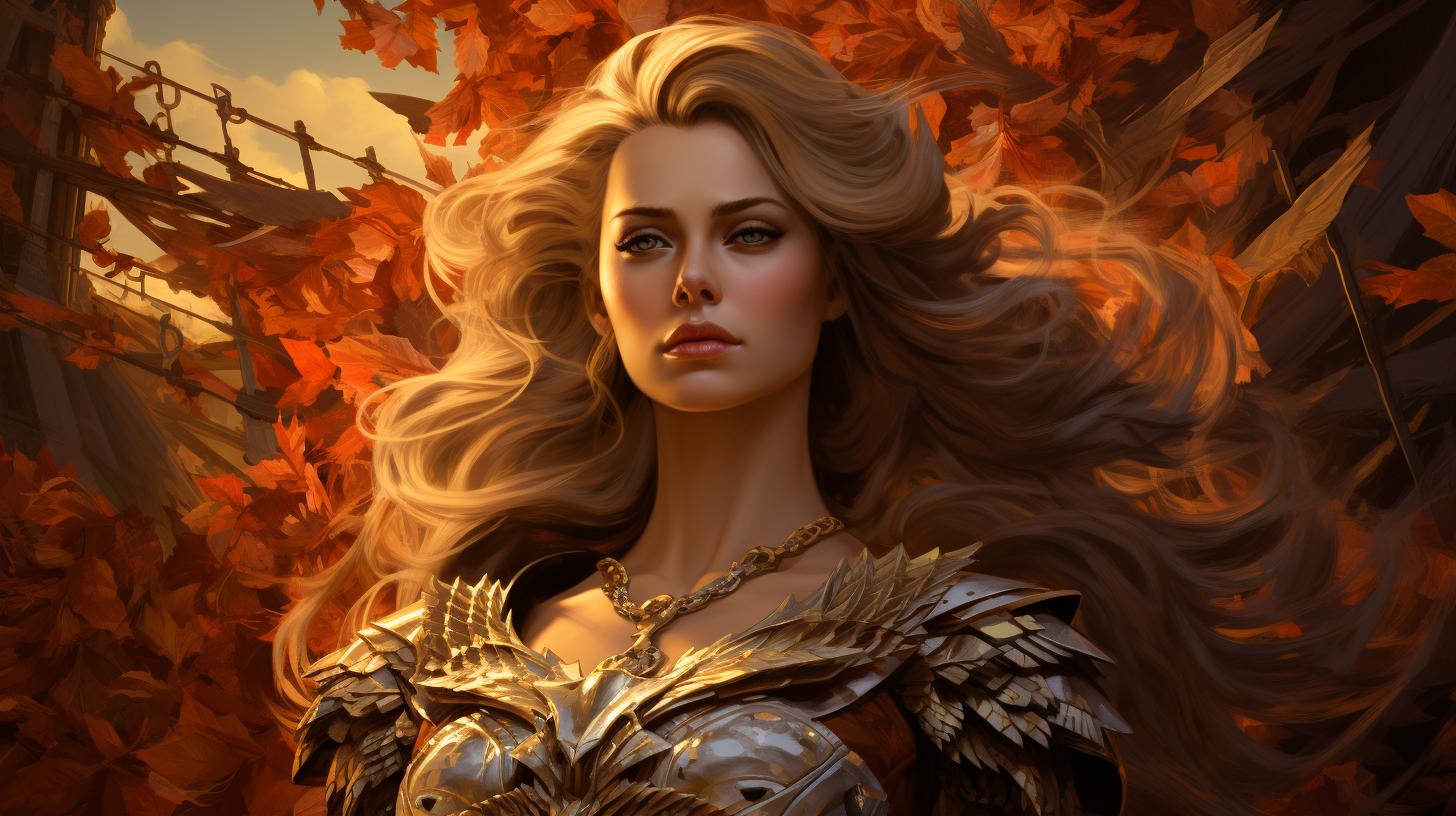
Pallas, a titan god of war in Greek mythology, played a significant role in the ancient Greek pantheon. He was the son of Crius and Eurybia and married to Styx, the goddess of hatred.
Pallas and Styx had four children, Zelos, Nike, Kratos, and Bia, who personified victory, zeal, strength, and power. Pallas is also associated with the constellation Auriga and is often depicted as a giant defeated by Athena during the Titanomachy.
His story is intertwined with various myths and legends, making him a prominent figure in Greek mythology.
Overview of Pallas in Greek Mythology
In Greek mythology, Pallas is a significant figure in the ancient pantheon. As a titanic god of war, he holds a prominent place in the tales and legends of the Greek gods and goddesses.
Pallas was the son of Crius and Eurybia, and he had two siblings named Astraeus and Perses. His marriage to Styx, the goddess of hatred, resulted in the birth of four powerful children: Zelos, Nike, Kratos, and Bia.
Pallas is often depicted as a giant who was defeated by the goddess Athena during the war of the Titans, known as the Titanomachy. In this epic battle between the Olympian gods and the Titans, Pallas stood on the opposing side of Athena, who fought valiantly for the Olympians.
Ultimately, Athena emerged victorious, using Pallas’ skin for protection in future battles and transforming his wings into a symbol of her ability to soar above the earth.
Aside from his role in the war of the Titans, Pallas is also associated with the constellation Auriga.
This connection stems from his significant astral qualities, adding an additional layer to his mythological presence. Interestingly, Pallas is often depicted as a goat-like giant, reflecting the Greek word “pallo,” meaning “spear.”
It is important to note that Pallas is not to be confused with other mythological figures also named Pallas. While common names can lead to overlap and confusion, Pallas, the god of war, has distinct characteristics and narratives separate from these other figures.
Overall, the mythological figure of Pallas presents an intriguing blend of war, astral symbolism, and familial connections within Greek mythology. His story and significance have captured the imaginations of countless storytellers throughout history, ensuring his enduring legacy in Greek mythos.
The Role of Pallas in the War of the Titans
In Greek mythology, Pallas played a significant role in the epic War of the Titans. As a titan god of war, Pallas was a formidable opponent and stood on the side of the Titans, who sought to overthrow the rule of the Olympian gods.
Pallas, along with his fellow Titans, waged a fierce and bloody battle against the Olympians, led by Zeus. The war was a monumental clash between the old order and the new, as the Olympians fought to establish their dominion over the cosmos.
According to the mythological accounts, Pallas possessed immense strength and was known for his prowess in combat. He was a relentless warrior, wielding his powerful weapons and commanding the Titans in their efforts to defeat the Olympians.
However, despite his ferocity and power, Pallas ultimately met his match in the form of the goddess Athena. In a dramatic confrontation during the Titanomachy, Athena emerged as a formidable warrior, standing against Pallas in a clash of titanic proportions.
Athena, the goddess of wisdom and warfare, brought her strategic brilliance and divine abilities to bear against Pallas. In an intense battle, she managed to overcome her adversary, defeating him and claiming victory for the Olympians.
As a result of his defeat, Athena claimed the spoils of war: Pallas’ skin for protection and his wings for flight. Utilizing these gifts, Athena further solidified her status as a fierce goddess of war and wisdom.
Pallas’ role in the War of the Titans served to highlight the conflict between the old and new generations of gods and the triumph of the Olympian forces. His defeat at the hands of Athena marked a pivotal moment in the mythological narrative, establishing the dominion of the Olympians and the decline of the Titans.
The story of Pallas’ involvement in the war showcases his importance in Greek mythology and his contribution to the overarching narrative of the divine struggle for power. It is a testament to the enduring themes of conflict, strength, and the ultimate triumph of the Olympian gods.
Pallas and Styx: The Divine Union
In Greek mythology, Pallas and Styx shared a divine union that played a significant role in the pantheon. Styx, the goddess of hatred, became the wife of Pallas, embodying the intense emotions associated with war and conflict.
Their union symbolized the deep connection between war and its visceral counterpart, hatred.
The bond between Pallas and Styx resulted in the birth of four powerful children: Zelos, Nike, Kratos, and Bia.
Each of them personified essential aspects of war and its aftermath. Zelos symbolized zeal, representing the passionate pursuit of victory. Nike embodied victory itself, bestowing honor upon those who emerged triumphant.
Kratos epitomized strength, the physical force required to succeed in battle. Bia represented the raw power and authority associated with warlords and leaders.
Together, Pallas and Styx established a formidable dynasty, with their children becoming influential deities in their own right.
The divine bloodline and their connection to warfare became intertwined throughout Greek mythology.
It is important to note that while Pallas and Styx’s union was significant, their relationship was not without complexities and challenges.
In some myths, their children, particularly Zelos and Nike, would align themselves with the gods of Mount Olympus, siding with the very deities that Pallas had opposed.
Despite these familial conflicts, the partnership between Pallas and Styx left a lasting impact on Greek mythology.
Their association with the divine realms of war, victory, and power continue to resonate within ancient Greek narratives.
Children of Pallas: Zelos, Nike, Kratos, and Bia
Pallas, the titan god of war, and Styx, the goddess of hatred, were the proud parents of four children who embodied various characteristics and attributes. Let us delve deeper into the lives of these remarkable offspring.
- Zelos: Zelos, the embodiment of rivalry and competition, represented the relentless pursuit of victory. Often depicted with a torch or a wreath, Zelos symbolized the burning desire to excel and emerge triumphant.
- Nike: Nike, the personification of victory, stood as a symbol of success and glory.
Often portrayed with wings and a laurel wreath, Nike represented the triumphant spirit that comes after achieving a noteworthy conquest.
- Kratos: Kratos embodied the concept of strength and power.
Depicted as a muscular figure with a forceful stance, Kratos represented the raw might and dominance that could be harnessed in times of battle.
- Bia: Bia, the embodiment of force and might, represented the physical and brute strength necessary for triumph in warfare.
Often depicted with a lion’s head or wielding a sword, Bia showcased the unyielding and indomitable spirit required in the heat of battle.
These four children of Pallas and Styx played significant roles in the ancient myths and legends of Greek mythology.
Their attributes and characteristics have been referenced in various literary works, showcasing the enduring legacy of the titan god of war and his divine progeny.
Pallas and Athena: Rivalry and Alliance
One of the most intriguing aspects of Pallas in Greek mythology is his complex relationship with Athena, the goddess of wisdom and battle strategy.
Their connection can be characterized by both rivalry and alliance, with their interactions playing a significant role in various myths and legends.
As the goddess of war, Athena naturally stood as a formidable opponent for Pallas.
According to the myths, the two engaged in a fierce battle during the Titanomachy, the war between the Titans and the Olympian gods. Pallas, a titan, ultimately met his defeat at the hands of Athena, a powerful Olympian goddess.
However, their rivalry did not end with Pallas’ defeat. In a surprising turn of events, Athena utilized a unique way to pay tribute to her fallen opponent. She took Pallas’ skin and used it as a protective shield in her battles.
Additionally, Athena fashioned Pallas’ wings into an emblem of her own power, using them to soar through the skies.
Despite their initial animosity, Pallas and Athena eventually found common ground and developed a symbiotic alliance.
The two deities shared similarities in their domains of warfare and combat strategies. Their partnership is believed to have deepened over time, especially during the war against the Olympian gods, where Pallas’ children and even Styx, his wife, reportedly sided with Zeus and the Olympians.
This alliance with Athena further enhanced Pallas’ significance in Greek mythology. It reinforced his role as a divine figure associated with war and symbolized the merging of different aspects of warfare under the guidance of Athena.
It is worth noting that different myths present varying accounts of Pallas’ connection to Athena. Some stories attribute Pallas as the father of Athena, while others suggest a more distant relation between them.
These variations reflect the diversity and complexities found within Greek mythology.
Pallas and Athena’s rivalry and alliance exemplify the intricate nature of relationships within Greek mythology. The blending of opposing forces and the eventual convergence of their objectives add depth and richness to the narratives surrounding these two powerful deities.
Pallas and his Association with the Constellation Auriga
Within the realm of Greek mythology, Pallas, the titan god of war, holds a fascinating connection with the constellation Auriga. This celestial association further enriches the complex tapestry of Pallas’ mythological narrative.
Auriga, represented by a charioteer, is a prominent constellation in the northern hemisphere. The name Auriga is derived from the Latin word for “charioteer,” symbolizing the connection between Pallas and his association with war.
The celestial image of a charioteer driving a chariot aligns with the enigmatic image of Pallas, a giant depicted with the appearance of a goat-like creature.
Interestingly, this connection between Pallas and Auriga extends beyond mere symbolism. Pallas is believed to have been transformed into the constellation Auriga after his defeat by Athena during the Titanomachy.
As a result, Pallas’ power and essence are immortalized and preserved in the night sky.
The significance of this association between Pallas and Auriga lies not only in the celestial tribute to Pallas’ mythological importance but also in the deeper metaphorical connection. Auriga, as a charioteer, represents the control and skill required to navigate the turbulent realms of war.
This echoes Pallas’ domain as the god of war, further reinforcing his role and influence over conflicts and battles.
In considering the association of Pallas with Auriga, we glimpse into the multifaceted dimensions of Greek mythology. The celestial realm intertwines with the divine narratives, shaping and enriching the intricate stories of the gods.
Pallas, forever linked to Auriga, stands as a testament to the enduring nature and timeless relevance of mythological tales.
As we marvel at the constellation Auriga in the night sky, we are reminded of Pallas’ everlasting presence and enduring legacy within the realm of Greek mythology.
Other Mentioned Figures Named Pallas in Greek Mythology
Pallas, the titan god of war, shares his name with a few other figures in Greek mythology.
These figures, although bearing the same name, have their own distinct stories and mythological connections.
Pallas, Son of Licaon
In some accounts, Pallas is mentioned as the son of Licaon, the king of Arcadia. Pallas, in this context, was a skilled teacher and mentor to Athena, the goddess of wisdom and warfare.
It is believed that Pallas taught Athena the art of combat and warfare, making him an influential figure in her development.
Pallas, Son of Pandion
A different Pallas, who was the son of Pandion, holds another significant role in Greek mythology. Pallas, in this instance, was the father of the fifty Pallantides, a group of fifty sons who were half-brothers to Aegeus, the mythological king of Athens.
These fifty sons played prominent roles in various myths and legends, each with their own individual stories and contributions to Greek mythology.
It’s important to note that while these figures bear the same name as Pallas, the titan god of war, they are separate entities with their own distinct mythological connections and narratives.
Mythological References to Pallas in Greek Literature
In Greek literature, Pallas is mentioned in various myths and texts, highlighting his significance in Greek mythology. Pallas is often depicted as a formidable opponent and a prominent figure in the war between the Titans and the Olympians.
One of the most well-known references to Pallas can be found in Hesiod’s “Theogony.” In this ancient poem, Pallas is described as a titan god of war who fought against Zeus and the other Olympian gods.
Although Pallas and his offspring ultimately faced defeat, their rebellion against the Olympians adds depth and complexity to the Greek mythological narrative.
Another notable mention of Pallas is found in the works of the tragedian Aeschylus.
In his play “Prometheus Bound,” Pallas is portrayed as one of the titan gods who suffer punishment at the hands of Zeus. This reference emphasizes the ongoing power struggle between the Titans and the Olympians and the consequences they face for their defiance.
Pindar, the ancient lyric poet, also alludes to Pallas in his writings. Pindar associates Pallas with the constellation Auriga, further reinforcing the celestial connections of this titan god.
References to Pallas in Epic Poetry
Pallas is frequently mentioned in epic poetry, particularly in Homer’s “Iliad” and “Odyssey.”
In the “Iliad,” Pallas is described as a powerful force on the battlefield, often inspiring and protecting the Greek heroes in their struggles against the Trojans. The interventions of Pallas are seen as pivotal in determining the outcomes of various battles.
In the “Odyssey,” Pallas is again depicted as a guardian figure, assisting Odysseus in his journey back home. Pallas provides guidance and protection, enabling the hero to overcome formidable challenges and obstacles.
Depictions in Other Literary Works
Pallas also makes appearances in other Greek literary works, such as Virgil’s “Aeneid.” In this epic poem, Pallas is associated with Athena, the goddess of wisdom and warfare, highlighting their shared attributes and roles in Greek mythology.
Various other poets and playwrights, including Sophocles and Euripides, incorporate references to Pallas in their works. These literary allusions contribute to the overall portrayal of Pallas as a significant and influential figure in Greek mythology.
Overall, Pallas is a recurring character in Greek literature, featured in myths, epic poems, and other literary works. These references emphasize the enduring presence and importance of Pallas within the rich tapestry of Greek mythology.
The Significance and Legacy of Pallas in Greek Mythology
In Greek mythology, Pallas holds a significant role and leaves behind a lasting legacy. As a titan god of war, Pallas embodied the primal forces of conflict, valor, and power.
His defeat at the hands of Athena in the War of the Titans symbolizes the triumph of wisdom and strategic warfare over brute strength.
One of the most noteworthy aspects of Pallas is his divine union with Styx, the goddess of hatred.
This union symbolizes the joining of two powerful forces, resulting in the birth of their four children: Zelos, Nike, Kratos, and Bia. Each of these offspring personifies different aspects related to victory, zeal, strength, and power.
Pallas is also associated with the constellation Auriga, which further emphasizes his celestial prominence. This connection highlights his enduring presence in the night sky and serves as a reminder of his celestial influence.
Throughout Greek mythology, various references to Pallas shed light on his interactions with other deities. The rivalry and alliance between Pallas and Athena, the goddess of wisdom and warfare, is a particularly fascinating aspect of their relationship.
While they initially clashed in battle, Athena eventually utilized Pallas’ skin for protection and his wings for flight. This fusion of their powers showcases the complex dynamics between them.
Furthermore, Pallas’ legacy extends beyond his immediate family.
In some versions of the myths, he is credited with fathering goddesses such as Selene, Athena, and Eos. However, these filial relationships vary depending on the specific myth being recounted.
The significance of Pallas in Greek literature and mythology cannot be overstated. His defeat by Zeus and subsequent imprisonment in the depths of Tartarus serves as a cautionary tale of the consequences of defying the will of the Olympian gods.
Pallas’ actions during the war against the Olympians resulted in his downfall and eternal punishment.
It is important to note that Pallas, the god of war, should not be confused with other mythological figures named Pallas.
These include Pallas, the son of Licaón, who served as a mentor to Athena, and Pallas, the son of Pandion, who was the father of the Pallantides.
In conclusion, Pallas, the titan god of war, played a significant role in Greek mythology.
His defeat by Athena, his divine union with Styx, and his association with the constellation Auriga all contribute to his enduring legacy. Through his complex relationships with other deities and his actions during the War of the Titans, Pallas remains a captivating figure whose significance and influence continue to resonate in Greek mythology.
Common Misconceptions and Confusions about Pallas
Despite being a prominent figure in Greek mythology, Pallas is often misunderstood, leading to various misconceptions and confusions about his character and role. Let’s debunk some of these misconceptions:
- Pallas as a Titan of Wisdom: One common misconception is associating Pallas with wisdom.
While Pallas is sometimes mentioned as Athena’s parent in certain myths, he is primarily known as a titan god of war, not wisdom.
- Pallas’s Appearance: Another misconception revolves around Pallas’s physical appearance.
Although some sources describe him as a giant with goat-like features, it is essential to note that Pallas’s appearance can vary as Greek mythology often contains different versions and interpretations.
- Pallas’s Role in the Olympian Gods: It is falsely believed by some that Pallas, his wife Styx, and their children sided with Zeus during the battle against the Titans.
However, the myths are inconsistent about their allegiances, and it is not clear whether they fought alongside the Olympian gods or against them.
- Pallas’s Relationship with Other Figures: Pallas is often confused with other mythological figures named Pallas, such as Pallas, the son of Licaón, who was a teacher of Athena. It is crucial to differentiate between these separate characters and their respective stories to avoid misunderstandings.
- Pallas’s Role in Creation: Some misconceptions attribute Pallas with the creation of natural elements like springs and lakes.
While Pallas is indeed associated with bodies of water in certain myths, his role in the creation of the natural world varies across different interpretations.
By clarifying these misconceptions and confusions, we can gain a more accurate understanding of Pallas’s role in Greek mythology and properly appreciate his significance within the pantheon of gods and titans.
Exploring Related Themes: The Raven Poem and the Meaning of Pallas
Within the realm of Greek mythology, the figure of Pallas has captured the imagination of poets, artists, and thinkers throughout the ages. One fascinating exploration of Pallas comes in the form of Edgar Allan Poe’s renowned poem, “The Raven.”
Poe’s poem delves into themes of loss, sorrow, and the lingering presence of the departed. It portrays the narrator’s encounter with a mysterious raven, who repeatedly utters the word “Nevermore.” While the poem may not directly reference Pallas, the mention of the bird does provide an intriguing connection to the titan god.
The raven has been traditionally associated with wisdom, and in Greek mythology, Pallas was known for his stance and intellect in battle. This shared symbolism raises questions about the potential deeper meanings within Poe’s poem.
Does the presence of the raven symbolize Pallas himself, perhaps representing his enduring legacy and wisdom?
Furthermore, the repeated utterance of “Nevermore” by the raven speaks to the theme of eternal absence and loss.
This resonates with Pallas’ defeat in the war against the Olympian gods and his subsequent imprisonment in the depths of the Underworld. The concept of never-ending absence and the longing for what was lost mirror the sorrow and despair experienced by the bereaved narrator in “The Raven.”
The Symbolic Value of Pallas in “The Raven”
By examining the deeper symbolism attached to Pallas and drawing connections to Poe’s poem, we can speculate on the potential meaning of Pallas’ presence within “The Raven.” This exploration invites us to consider themes of wisdom, battle, loss, and the enduring impact of mythological figures in literature and art.
Interpretations and Scholarly Perspectives
Poe’s “The Raven” has captivated scholars and enthusiasts, leading to various interpretations and discussions. Experts have contemplated the significance of the raven as a symbol and its potential ties to mythological characters like Pallas.
Some scholars argue that Poe drew inspiration from Pallas’ association with wisdom and employed the raven as a vehicle for conveying profound truths and eternal absence. Others suggest that the raven could represent the shadow of Pallas—a constant reminder of defeat and the enduring legacy of the titan god.
A Window into the Human Experience
Exploring the poetic connection between Pallas and “The Raven” offers a glimpse into the enduring influence of Greek mythology on literature and art. It demonstrates how mythological figures continue to inspire and shape our understanding of the human experience.
In wrapping ourselves in the rich tapestry of Pallas’ story and its possible connections to “The Raven,” we gain a deeper appreciation for the profound and multi-layered impact of mythology in our cultural landscape.
As we continue to explore the themes, symbols, and narratives woven within ancient myths, we uncover new depths and interpretations that shed light on the human condition and our eternal fascination with the divine.
.











